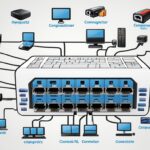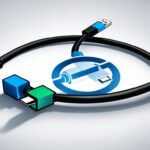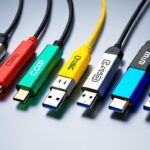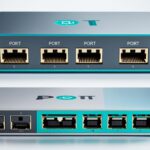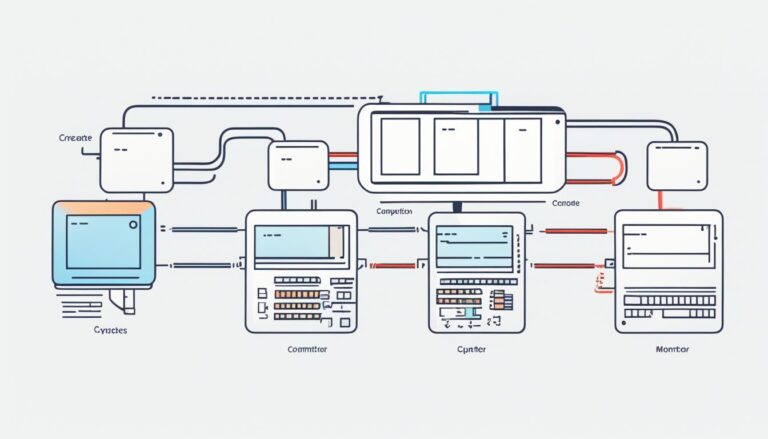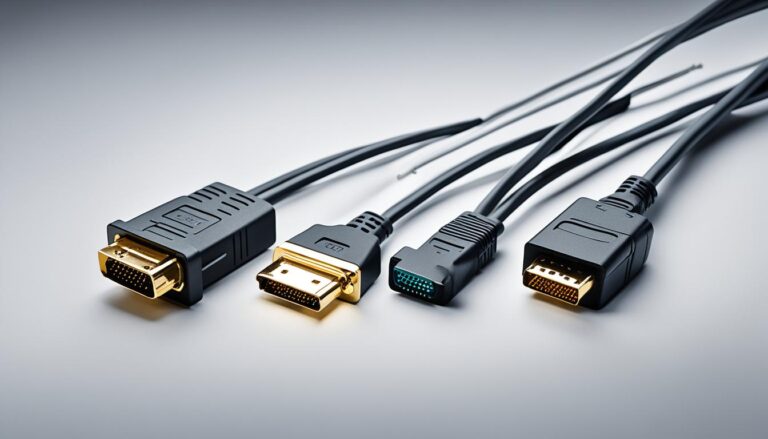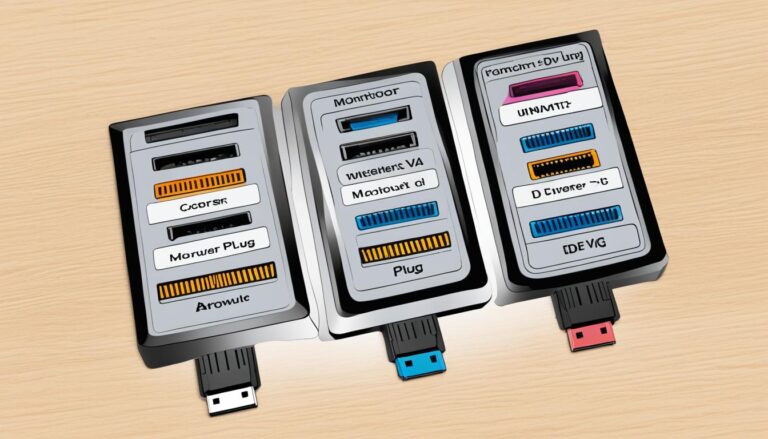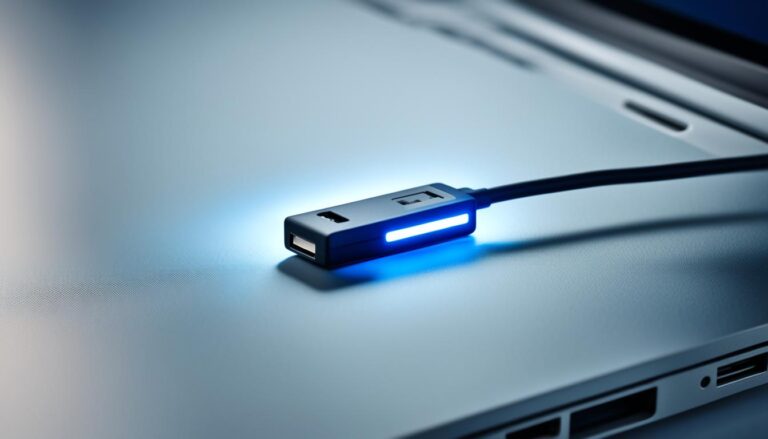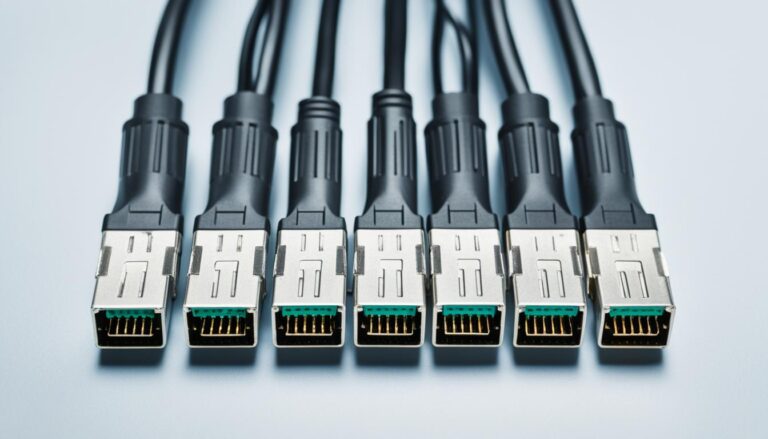Buttons USB are key parts of today’s tech, used for interacting with many devices. You can find them on computers and various gadgets. They let us connect items like mice, keyboards, and cameras.
In this piece, we will dig into how buttons USB work and why they’re important. We’ll look at the different kinds available and what they do. This will cover everything from computer ports to USB types and their powers.
Also, we’ll check out the cool uses for USB buttons. This includes how they work with stuff like printers and game controllers. We’ll even talk about the speed of USB ports and how long cables should be. Plus, we’ll look at specific USB pushbuttons.
Learning about buttons USB will help you get more from your devices. Join us as we explore the interesting world of USB technology.
Buttons and Ports on a Computer
Computers come packed with buttons and ports for linking various devices and peripherals. These components are key to improving how we use computers.
Front Buttons
On the computer’s front, there are buttons for quick access. You’ll find the power button to switch the computer on or off. There’s also a button to eject CDs or DVDs. Plus, audio in/out buttons let you manage sound inputs and outputs.
Back Ports
The back of a computer has many ports for connecting devices. The Universal Serial Bus (USB) port is most common for hooking up keyboards, mice, and more. You’ll also see audio ports for headphones and speakers. An ethernet port allows wired network connections, and there’s a port to connect your display. Other ports support additional connections.
Importance of Buttons and Ports
The buttons and ports are vital for linking and controlling devices. Without them, using the computer fully would be tough. They make it easy to plug in USB devices, connect headphones, or use the power button. These features ensure smooth experiences for users.
Types of USB Ports
USB ports are key to connecting various devices to computers. But, not all USB ports are alike. They vary in specifications and what they can do.
The most commonly used USB ports are:
- USB Type-A: This is the standard, rectangular-shaped USB port found on many devices. It connects peripherals like keyboards and printers.
- USB Type-B: Used mainly for printers and scanners, this port has a square shape with rounded corners.
- USB Type-C: The latest and most flexible, USB Type-C is small and reversible. It’s found on new laptops and phones.
- Micro-B: Micro-B ports are on smaller gadgets like smartphones. They’re smaller than Type-A and have a distinct shape.
- Mini-A: Mini-A ports were for older devices. They’re smaller than Type-A and are no longer common.
- Mini-B: Like Mini-A, Mini-B is less common now. They were mainly for older cameras and MP3 players.
- Micro-AB: Micro-AB ports combine Micro-A and Micro-B. They work with devices that have either port type.
USB ports support different versions like USB 2.0 and USB 3.0. These determine the port’s speed and capabilities. For instance, USB 2.0 handles 480 Mbps, while USB 3.0 can do up to 5 Gbps. Remember, actual speeds also depend on the device and cable used.
| Type of USB Port | USB Version | Maximum Speed | Cable Length Limit |
|---|---|---|---|
| USB Type-A | USB 2.0 / USB 3.0 / USB 3.1 Gen 1 / USB 3.1 Gen 2 | 480 Mbps / 5 Gbps / 10 Gbps | 16 feet |
| USB Type-B | USB 2.0 / USB 3.0 / USB 3.1 Gen 1 / USB 3.1 Gen 2 | 480 Mbps / 5 Gbps / 10 Gbps | 16 feet |
| USB Type-C | USB 2.0 / USB 3.0 / USB 3.1 Gen 1 / USB 3.1 Gen 2 | 480 Mbps / 5 Gbps / 10 Gbps | 16 feet (USB 2.0) / 9 feet (USB 3.0) |
| Micro-B | USB 2.0 / USB 3.0 / USB 3.1 Gen 1 / USB 3.1 Gen 2 | 480 Mbps / 5 Gbps / 10 Gbps | 16 feet |
| Mini-A | USB 2.0 | 480 Mbps | N/A |
| Mini-B | USB 2.0 | 480 Mbps | N/A |
| Micro-AB | USB 2.0 | 480 Mbps | 16 feet |
Knowing the different USB ports ensures you connect devices properly. It helps use devices to their full potential. Whether it’s for fast file transfer or linking up a hard drive, the correct USB makes a big difference.
Features of a Programmable USB Button
A programmable USB button is full of features that make using your devices easier. It acts like a keyboard or mouse, letting you press keys or click without a fuss. You can do simple tasks or complex ones with these buttons.
These buttons can do many keyboard tasks at once. This means you can automate boring tasks easily. Typing out long bits of text becomes quicker, saving you time.
These buttons work with lots of operating systems, like Windows, Apple iOS, Linux, and Android. They’re flexible and handy for everyone, no matter your device.
These buttons are tough and can handle a lot of use. They are made to last and keep working well, even with lots of use.
There’s also memory inside these buttons. This lets you keep different settings saved. You can change between them easily, without having to set them up again.
When it comes to what these buttons can do, the choices are many. They have different lifespans, sizes, and meet certain standards. They’re designed to fit what you need from them.
Overall, programmable USB buttons make your work easier and more efficient. They are durable, flexible, and can be set up just how you like. This makes controlling your devices simple and effective.
| Features | Functionality | Technical Specifications |
|---|---|---|
| Simulates HID keyboard and mouse devices | Allows users to input keystrokes and mouse clicks | Button lifespan: Varies based on model Dimensions: Varies based on model Compliance with certified product standards |
| Simulates multiple keyboard keys in parallel or sequence | Enables automation of complex commands and workflows | |
| Types whole strings on the keyboard | Simplifies the execution of repetitive tasks | |
| Compatible with various operating systems | Works seamlessly across Windows, Apple iOS, Linux, and Android | |
| Durable and vandal-proof | Withstands extensive usage without performance degradation | |
| Internal memory for storing settings | Allows easy recall and switching between configurations |
Applications of USB Buttons
USB buttons have many uses and work well with different devices to improve their functions and make them easier to use. Let’s look at some key uses of USB buttons:
1. Printers
Connecting USB buttons to printers makes printing documents and photos easy. Just press a button to print without going through complex settings. This saves time and makes the process simpler.
2. Scanners
USB buttons also help with scanners, making it easy to digitize images and documents. A single click starts the scan. Then, you can store, share, or edit the scanned files with ease.
3. Audio Devices
Speakers and headphones work well with USB buttons for audio use. They let you manage the volume and other sound settings easily. This ensures a smooth and hassle-free audio experience.
4. Microphones
Microphones can be controlled easily with USB buttons. They help with muting, adjusting sensitivity, or starting voice recording. This makes using microphones more straightforward and intuitive.
5. Web Cameras
USB buttons boost web camera functions significantly. They allow easy start and stop of video recording, image capture, and more. This helps in video calls, live streaming, and making content smoothly.
6. Game Controllers
USB buttons can also enhance gaming by acting as controllers. Gamers can set up buttons for specific actions. This personalizes their gaming setup, making the experience more fun and immersive.
7. Digital Cameras and Mobile Phones
Connecting USB buttons to cameras and phones eases control and file transfer. You can take photos, record videos, adjust settings, and move files with a button press. This simplifies managing these devices.
“USB buttons provide a versatile solution for improving device functionality. From easy printing and scanning to better audio control and gaming, USB buttons make interacting with devices simpler and more efficient.”
By discovering and using USB buttons’ many applications, users can make the most of their devices. This boosts productivity and enhances the user experience.
USB Port Speeds and Cable Lengths
USB ports come in different versions, each offering varied speeds and cable lengths. It’s crucial to know these for fast data transfer and connecting devices.
USB 2.0: USB 2.0 ports can reach up to 480 Mbps. They support cables as long as 16 feet.
USB 3.0 (or USB 3.1 Gen 1): For faster transfer, USB 3.0 ports go up to 5 Gbps. However, cables can only be up to 9 feet.
USB-C: The versatile USB-C supports speeds from 480 Mbps to 10 Gbps. It depends on the device and cable used. For USB 2.0, cables can be 16 feet long. For USB 3.0, they can be up to 9 feet long.
Knowing about USB port speeds and cable lengths helps in picking the right connections. This ensures the best performance when linking devices to computers or other USB supports.
| USB Version | Maximum Speed | Cable Lengths |
|---|---|---|
| USB 2.0 | 480 Mbps | Up to 16 feet |
| USB 3.0 (USB 3.1 Gen 1) | 5 Gbps | Up to 9 feet |
| USB-C | 480 Mbps to 10 Gbps | Up to 16 feet (USB 2.0), Up to 9 feet (USB 3.0) |
Specifications of a USB Pushbutton
USB pushbuttons are made to fit many uses. They last a long time, with a life of 1 million presses. These buttons can handle rough use, making them perfect for busy places. They also come in various sizes to fit into different spaces easily.
Mounting these pushbuttons is simple thanks to their design. They have special holes that make them easy to install anywhere you need them. This means they can be set up quickly without much trouble.
Additionally, these pushbuttons follow important standards like IEC/EN 60947. These rules make sure the pushbuttons are safe and up to the mark. By meeting these standards, users can be confident in their choice.
USB pushbuttons are also built to resist water and dust, thanks to ratings like IP67 and IP69K. Whether inside or out, they perform well in tough conditions. These ratings help them stay in good shape for a long time, despite the weather.
Choosing the right USB pushbutton means looking at different features. Consider things like how long they last, size, how to install them, and the safety standards they meet. Keeping these points in mind will help you pick the best option for your needs.
Conclusion
Buttons USB are crucial for making modern devices more useful and easy to use. Users can connect devices like printers and control them easily. Knowing about different USB buttons improves how we use our devices. This includes printing, scanning, and playing games.
Indeed, buttons USB make life in the digital world a lot easier. They help connect devices and make them work better together. By using USB buttons, we can do more, like print documents and share data. These buttons make daily tasks easier and help users get the most from their devices.
Discover the benefits of using buttons USB and make your devices do more. Find out how they work and what they can do to improve your tech life. Whether for work or fun, buttons USB can make a big difference in how you connect and use your devices.
FAQ
What are buttons USB?
USB buttons help us control devices. They are key for interacting with many functions.
Where can buttons USB be found?
You can find USB buttons on things like desktops, laptops, and keyboards.
What are some common buttons and ports found on a computer case?
Common computer case buttons include the power and optical disc drive buttons. Audio in/out buttons are also found.
The back has USB, audio, and ethernet ports. You’ll find monitor and serial ports too, along with expansion slots.
What are the different types of USB ports?
USB ports come in various types. These include USB Type-A, Type-B, Type-C, and several others.
What are the different versions of USB supported by these ports?
USB ports support versions like USB 2.0, USB 3.0, and USB 3.1 Gen 2.
What is a programmable USB button?
A programmable USB button has lots of uses. It can perform clicks, press keys, and imitate several keys at once.
It works with many operating systems. It has a long life and comes in various sizes.
What are the applications of USB buttons?
USB buttons help with many devices. They’re used in printers, scanners, and even game controllers.
They aid in printing, audio control, video recording, gaming, and moving data.
What are the maximum speeds and cable lengths for different versions of USB ports?
USB 2.0 ports can go up to 480 Mbps and can be 16 feet long. USB 3.0 ports are faster at 5 Gbps, with 9 feet cables.
USB-C ports are very versatile. They support speeds from 480 Mbps to 10 Gbps and have 16 feet (USB 2.0) or 9 feet (USB 3.0) cables.
What are the specifications of a USB pushbutton?
A USB pushbutton lasts for at least 1 million presses. It’s tough and meets certain standards.
It comes in different sizes and can be securely fixed in place. It’s also protected against water and weather conditions.

